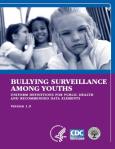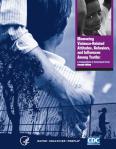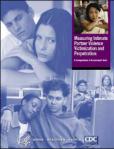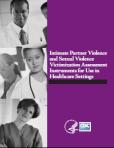Resources
On this page I hope, over time, to build a series of resources to access for research purposes. Wherever possible I will identify how permissions should be sought and if there are fees for the use of these resources.
Bullying Surveillance Among Youths: Uniform Definitions for Public Health and Recommended Data Elements, Version 1.0. produced by the Centers for Disease Control and Prevention.
 This resource together with its recommended data elements is designed as a tool to help organisations, researchers, evaluators, community groups, educators, and public health officials define and gather systematic data on bullying to better inform research and prevention efforts in the US. It is intended to improve the consistency and comparability of data collected on bullying. Current efforts to characterise bullying vary considerably. The lack of a uniform definition hinders our ability to understand the true magnitude, scope, and impact of bullying and track trends over time. Consistent terminology with standardised definitions is necessary to improve public health surveillance of bullying and inform efforts to address bullying.
This resource together with its recommended data elements is designed as a tool to help organisations, researchers, evaluators, community groups, educators, and public health officials define and gather systematic data on bullying to better inform research and prevention efforts in the US. It is intended to improve the consistency and comparability of data collected on bullying. Current efforts to characterise bullying vary considerably. The lack of a uniform definition hinders our ability to understand the true magnitude, scope, and impact of bullying and track trends over time. Consistent terminology with standardised definitions is necessary to improve public health surveillance of bullying and inform efforts to address bullying.
Further information can be obtained here.
Measuring Bullying Victimization, Perpetration, and Bystander Experiences: A Compendium of Assessment Tools, produced by the Centers for Disease Control and Prevention, USA.
 This compendium provides researchers, prevention specialists, and health educators with tools to measure a range of bullying experiences: bully perpetration, bully victimization, bully-victim experiences, and bystander experiences. Some researchers continue to examine the risk and protective factors associated with bullying experiences. Others are working to design, implement, and evaluate bully prevention interventions aimed at reducing bully victimization and perpetration, as well as increasing prosocial bystander involvement in bullying situations. The ability to measure bullying experiences broadly and completely is crucial to the success of these activities. This compendium represents a starting point from which researchers can consider a set of psychometrically-sound measures for assessing self-reported incidence and prevalence of a variety of bullying experiences. Information on permissions to use the various measures is provided.
This compendium provides researchers, prevention specialists, and health educators with tools to measure a range of bullying experiences: bully perpetration, bully victimization, bully-victim experiences, and bystander experiences. Some researchers continue to examine the risk and protective factors associated with bullying experiences. Others are working to design, implement, and evaluate bully prevention interventions aimed at reducing bully victimization and perpetration, as well as increasing prosocial bystander involvement in bullying situations. The ability to measure bullying experiences broadly and completely is crucial to the success of these activities. This compendium represents a starting point from which researchers can consider a set of psychometrically-sound measures for assessing self-reported incidence and prevalence of a variety of bullying experiences. Information on permissions to use the various measures is provided.
Measuring Violence-Related Attitudes, Behaviors, and Influences Among Youths: A Compendium of Assessment Tools (2nd Ed), produced by the Centers for Disease Control and Prevention, USA.
This co mpendium provides researchers and prevention specialists with a set of tools to assess violence-related beliefs, behaviours, and influences, as well as to evaluate programmes that prevent youth violence. Both new and experienced researchers will find this compendium useful.
mpendium provides researchers and prevention specialists with a set of tools to assess violence-related beliefs, behaviours, and influences, as well as to evaluate programmes that prevent youth violence. Both new and experienced researchers will find this compendium useful.
Information on authorisation to use the measures in this compendium is provided.
Measuring Intimate Partner Violence Victimization and Perpetration: A Compendium of Assessment Tools, Produced by the Centers for Disease Control and Prevention, USA.
 This compendium provides researchers and prevention specialists with a compilation of tools designed to measure victimisation and perpetration of Intimate Partner Violence (IPV) also known as Domestic Violence (DV). Many researchers are conducting studies to identify risk and protective factors for IPV and determine the consequences of victimisation and perpetration. Others are working to design, implement, and evaluate interventions to reduce
This compendium provides researchers and prevention specialists with a compilation of tools designed to measure victimisation and perpetration of Intimate Partner Violence (IPV) also known as Domestic Violence (DV). Many researchers are conducting studies to identify risk and protective factors for IPV and determine the consequences of victimisation and perpetration. Others are working to design, implement, and evaluate interventions to reduce
IPV victimisation and perpetration.
There is also an additional compendium of assessment tools for health care  practitioners assessing IPV entitled, Intimate Partner Violence and Sexual Violence Victimization Assessment Instruments for Use in Healthcare Settings.
practitioners assessing IPV entitled, Intimate Partner Violence and Sexual Violence Victimization Assessment Instruments for Use in Healthcare Settings.
 In 2011, a report CDC produced a report using data drawn from the Youth Risk Behaviour Surveillance Surveys at selected sites conducted between 2001 and 2009 where sexual orientation was asked. The authors found that LGB youth are less likely to take physical education classes at school, are more likely to fast, take dietary products or use laxatives to lose weight, and are at increased risk of obesity.
In 2011, a report CDC produced a report using data drawn from the Youth Risk Behaviour Surveillance Surveys at selected sites conducted between 2001 and 2009 where sexual orientation was asked. The authors found that LGB youth are less likely to take physical education classes at school, are more likely to fast, take dietary products or use laxatives to lose weight, and are at increased risk of obesity.
The 133 page Morbidity and Mortality Weekly Report (MMWR) produced by the CDC’s Division of School and Adolescent Health (DASH), collated data from seven states (Connecticut, Delaware, Maine, Massachusetts, Rhode Island, Vermont, and Wisconsin) and six cities (Boston, Chicago, Milwaukee, NYC, San Diego, San Francisco) from 2001-2009.